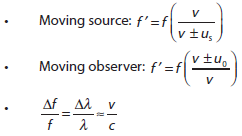Understandings:
- The Doppler effect for sound waves and light waves
Applications and skills:
- Sketching and interpreting the Doppler effect when there is relative motion between source and observer
- Describing situations where the Doppler effect can be utilized
- Solving problems involving the change in frequency or wavelength observed due to the Doppler effect to determine the velocity of the source/observer
Guidance:
- For electromagnetic waves, the approximate equation should be used for all calculations
- Situations to be discussed should include the use of Doppler effect in radars and in medical physics, and its significance for the red-shift in the light spectra of receding galaxies
Data booklet reference:

|
International-mindedness:
- Radar usage is affected by the Doppler effect and must be considered for applications using this technology
Theory of knowledge:
- How important is sense perception in explaining scientific ideas such as the Doppler effect?
Utilization:
- Astronomy relies on the analysis of the Doppler effect when dealing with fast moving objects (see Physics option D)
Aims:
- Aim 2: the Doppler effect needs to be considered in various applications of technology that utilize wave theory
- Aim 6: spectral data and images of receding galaxies are available from professional astronomical observatories for analysis
- Aim 7: computer simulations of the Doppler effect allow students to visualize complex and mostly unobservable situations
|

